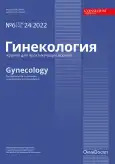Latent iron deficiency therapy in pregnant women
- Authors: Kutsenko I.I.1, Kravtsova E.I.1, Kholina L.A.1, Tomina O.V.1
-
Affiliations:
- Kuban State Medical University
- Issue: Vol 24, No 6 (2022)
- Pages: 512-517
- Section: ORIGINAL ARTICLE
- URL: https://ogarev-online.ru/2079-5831/article/view/148276
- DOI: https://doi.org/10.26442/20795696.2022.6.202023
- ID: 148276
Cite item
Full Text
Abstract
According to various studies, the overall population incidence of latent iron deficiency (LID) ranges from 70% and more. However, routine tests cannot detect LID during preconception examination and in the first trimester of pregnancy; therefore, women receive no proper treatment, and iron deficiency manifest in the second and third trimesters of pregnancy. LID causes hypoxia, leading to pregnancy, labor, and postpartum complications.
Aim. To evaluate the effectiveness of iron with folic acid supplements compared to vitamin-mineral complexes in pregnant women with LID to improve maternal and perinatal outcomes.
Materials and methods. A prospective cohort non-interventional study (observational program) in real clinical practice was conducted. In total 461 pregnant women aged 19 to 35 with LID were included in the study. During the study, women were divided into two groups according to the method of LID correction: administration of iron sulfate 247.25 mg, which corresponds to an iron content of 80 mg + folic acid 350 μg (Gyno-Tardyferon®), or vitamin-mineral complexes with an iron content of 14–18 mg. Routine complete blood count, serum iron, serum ferritin, and transferrin were monitored over time.
Results. Gyno-Tardyferon® showed high therapeutic and prophylactic efficacy; the rate of favorable outcomes was 100% and 35% for multivitamin iron-containing complexes. No LID progression to manifest iron deficiency during pregnancy can also be considered a favorable outcome.
Conclusion. The results showed that timely treatment of LID with an iron-containing medication (Gyno-Tardyferon®) prevents manifested iron deficiency and hemic and circulatory hypoxia, which ultimately reduces the rate of pregnancy, labor, and postpartum complications.
Full Text
##article.viewOnOriginalSite##About the authors
Irina I. Kutsenko
Kuban State Medical University
Email: iikucenko@mail.ru
ORCID iD: 0000-0003-0938-8286
SPIN-code: 7912-9184
D. Sci. (Med.), Prof., Kuban State Medical University
Russian Federation, KrasnodarElena I. Kravtsova
Kuban State Medical University
Author for correspondence.
Email: luzum69@mail.ru
ORCID iD: 0000-0001-8987-7375
SPIN-code: 5579-9910
Cand. Sci. (Med.), Kuban State Medical University
Russian Federation, KrasnodarLyudmila A. Kholina
Kuban State Medical University
Email: holina1667@mail.ru
ORCID iD: 0000-0002-6778-4087
SPIN-code: 5011-2962
Cand. Sci. (Med.), Kuban State Medical University
Russian Federation, KrasnodarOksana V. Tomina
Kuban State Medical University
Email: tominaoksana@mail.ru
ORCID iD: 0000-0002-2986-0202
Cand. Sci. (Med.), Kuban State Medical University
Russian Federation, KrasnodarReferences
- Доброхотова Ю.Э., Бахарева И.В. Железодефицитная анемия: профилактика и лечение при беременности. Лечебное дело. 2016;3:4-13 [Dobrokhotova YuE, Bakhareva IV. Iron deficiency anemia: prevention and treatment during pregnancy. Medical Business. 2016;3:4-13 (in Russian)].
- Дикке Г.Б., Стуклов Н.И. Латентный дефицит железа и железодефицитная анемия у беременных. Алгоритмы диагностики и лечения. Фарматека. 2021;28(6):19-24 [Dikke GB, Stuklov NI. Latent iron deficiency and iron deficiency anemia in pregnant women. Algorithms of diagnosis and treatment. Pharmateca. 2021;28(6):19-24 (in Russian)].
- Зефирова Т.П., Юпатов Е.Ю., Мухаметова Р.Р. Железодефицитная анемия в акушерской практике. РМЖ. Мать и дитя. 2021;4(1):53-8 [Zefirova TP, Yupatov EYu, Mukhametova RR. Iron deficiency anemia in obstetric practice. RMJ. Mother and child. 2021;4(1):53-8 (in Russian)]. doi: 10.32364/2618-8430-2021-4-1-53-58
- Большакова М.В., Беженарь В.Ф., Павлова Н.Г., и др. Современные представления о патогенезе гипоксии плода и роли в нем гипоксия-индуцируемого фактора (HIF). Акушерство и гинекология Санкт-Петербурга. 2019;1:19-24 [Bolshakova MV, Refugee VF, Pavlova NG, et al. Modern ideas about the pathogenesis of fetal hypoxia and the role of hypoxia-induced factor (HIF) in it. Obstetrics and Gynecology of St. Petersburg. 2019;1:19-24 (in Russian)].
- Greenberg JA, Bell SJ, Guan Y, Yu YH. Folic Acid supplementation and pregnancy: more than just neural tube defect prevention. Rev Obstet Gynecol. 2011;4(2):52-9.
- Handiso YH, Belachew T, Abuye C, et al. A community-based randomized controlled trial providing weekly iron-folic acid supplementation increased serum-ferritin, -folate and hemoglobin concentration of adolescent girls in southern Ethiopia. Sci Rep. 2021;11(1):9646. doi: 10.1038/s41598-021-89115-5









